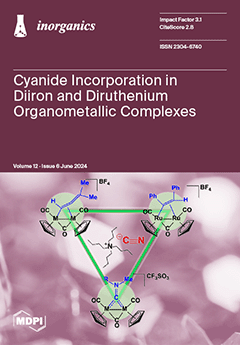We conducted a joint synthetic, spectroscopic and computational study to explore the reactivity towards cyanide (from Bu
4NCN) of a series of dinuclear complexes based on the M
2Cp
2(CO)
3 scaffold (M = Fe, Ru; Cp = η
5-C
5H
5), namely [M
2Cp
2(CO)
2(µ-CO){µ,η
1:η
2-CH=C=CMe
2}]BF
4 (
1Fe-Ru), [Ru
2Cp
2(CO)
2(µ-CO){µ,η
1:η
2-C(Ph)=CHPh}]BF
4 (
2Ru) and [M
2Cp
2(CO)
2(µ-CO){µ-CN(Me)(R)}]CF
3SO
3 (
3Fe-Ru). While the reaction of
1Fe with Bu
4NCN resulted in prevalent allenyl deprotonation, preliminary CO-NCMe substitution in
1Ru enabled cyanide addition to both the allenyl ligand (resulting in the formation of a h
1:h
2-allene derivative,
5A) and the two metal centers (affording
5B1 and
5B2). The mixture of
5B1-2 was rapidly converted into
5A in heptane solution at 100 °C, with
5A being isolated with a total yield of 60%. Following carbonyl-chloride substitution in
2Ru, CN
− was incorporated as a terminal ligand upon Cl
− displacement, to give the alkenyl complex
6 (84%). The reactivity of
3Fe and
3Ru is strongly influenced by both the metal element, M, and the aminocarbyne substituent, R. Thus,
7aRu was obtained with a 74% yield from cyanide attack on the carbyne in
3aRu (R = Cy, cyclohexyl), whereas the reaction involving the diiron counterpart
3aFe yielded an unclean mixture of the metastable
7aFe and the CO/CN
− substitution product
8aFe. The cyano-alkylidene complexes
7aRu (R = Cy) and
7bFe (R = Me) underwent CO loss and carbene to carbyne conversion in isopropanol at 60–80 °C, giving
8aRu (48%) and
8bFe (71%), respectively. The novel compounds
5A,
5B1-2,
6 and
7aRu were characterized by IR and NMR spectroscopy, with the structure of
7aRu further elucidated by single crystal X-ray diffraction analysis. Additionally, the DFT-optimized structures of potential isomers of
5A,
5B1-2 and
6 were calculated.
Full article





